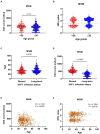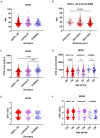Young MSM changed temporal HIV-1 epidemic pattern in Heilongjiang Province, China
- PMID: 36504809
- PMCID: PMC9732660
- DOI: 10.3389/fmicb.2022.1028383
Young MSM changed temporal HIV-1 epidemic pattern in Heilongjiang Province, China
Abstract
Background: Human immunodeficiency virus type 1 (HIV-1) epidemic in China is featured by geographical diversity of epidemic patterns. Understanding the characteristics of regional HIV-1 epidemic allows carrying out targeted prevention and controlling measures. This seven-year cross-sectional study was conducted in Heilongjiang, one province of Northeast China, where newly diagnosed infection is fast increasing yearly, but temporal HIV-1 epidemic trend is largely unknown.
Methods: Information of 1,006 newly diagnosed HIV-1-infected participants were collected before antiretroviral therapy during 2010-2016 in Heilongjiang province. HIV-1 genotype was identified based on the viral gag and env gene sequences. Recent infection was determined by Limiting-Antigen Avidity assays. Comparison analyses on the median ages, CD4 counts, proportions of stratified age groups and CD4 count groups, and rates of recent HIV-1 infection among different population and sampling times were performed to understand temporal HIV-1 epidemic features.
Results: Homosexual contact among men who have sex with men (MSM) was the main transmission route and CRF01_AE was the most dominant HIV-1 genotype. During 2010-2016, the HIV-1 epidemic showed three new changes: the median age continued to decline, the cases with a CD4 count more than 500 cells/μl (CD4hi cases) disproportionally expanded, and the recent HIV-1 infection rate steadily increased. MSM cases determined the temporal trend of HIV-1 epidemic here. Increase of young MSM cases (aged <30 years) made the main contribution to the younger age trend of MSM cases. These young MSM exhibited a higher median CD4 count, a higher proportion of CD4hi cases, and a higher rate of recent HIV-1 infection than cases aged 30 years and more. MSM infected by CRF01_AE virus mostly affected HIV-1 epidemic patterns among MSM population.
Conclusion: Young MSM have become a new hotspot and vulnerable group for HIV-1 transmission in Heilongjiang Province, Northeast China. The rapid increase in the number of young MSM cases, mainly those with CRF01_AE infection, changed temporal HIV-1 epidemic pattern here. Measures for prevention and control of HIV-1 infection among this population are urgently needed in the future.
Keywords: CRF01_AE; HIV-1 epidemic; immune status; recent infection; young men who have sex with men.
Copyright © 2022 Li, Wang, Liu, Zhang, Li, Wang, Zhang, Zhao, Liu, Chen and Wang.
Conflict of interest statement
The authors declare that the research was conducted in the absence of any commercial or financial relationships that could be construed as a potential conflict of interest.
Figures



Similar articles
-
Evidence that HIV-1 CRF01_AE is associated with low CD4+T cell count and CXCR4 co-receptor usage in recently infected young men who have sex with men (MSM) in Shanghai, China.PLoS One. 2014 Feb 21;9(2):e89462. doi: 10.1371/journal.pone.0089462. eCollection 2014. PLoS One. 2014. PMID: 24586795 Free PMC article.
-
Rapid CD4+ T-cell decline is associated with coreceptor switch among MSM primarily infected with HIV-1 CRF01_AE in Northeast China.AIDS. 2019 Jan 27;33(1):13-22. doi: 10.1097/QAD.0000000000001981. AIDS. 2019. PMID: 30102662
-
HIV-1 genetic transmission networks among men who have sex with men in Kunming, China.PLoS One. 2018 Apr 26;13(4):e0196548. doi: 10.1371/journal.pone.0196548. eCollection 2018. PLoS One. 2018. PMID: 29698467 Free PMC article.
-
Impact of HIV-1 CRF55_01B infection on the evolution of CD4 count and plasma HIV RNA load in men who have sex with men prior to antiretroviral therapy.Retrovirology. 2021 Aug 16;18(1):22. doi: 10.1186/s12977-021-00567-z. Retrovirology. 2021. PMID: 34399785 Free PMC article.
-
The prevalence, temporal trends, and geographical distribution of HIV-1 subtypes among men who have sex with men in China: A systematic review and meta-analysis.Epidemiol Infect. 2019 Jan;147:e83. doi: 10.1017/S0950268818003400. Epidemiol Infect. 2019. PMID: 30869019 Free PMC article.
Cited by
-
Characterization of the HIV-1 molecular network in a middle-aged population aged 50 years and older in a City in Southern Sichuan, China.Sci Rep. 2025 Mar 26;15(1):10500. doi: 10.1038/s41598-025-95660-0. Sci Rep. 2025. PMID: 40140708 Free PMC article.
-
Preferences for eHealth interventions to improve sexual health and prevent HIV for Vietnamese young men who have sex with men.Health Promot Int. 2025 May 13;40(3):daaf060. doi: 10.1093/heapro/daaf060. Health Promot Int. 2025. PMID: 40402019
-
HIV in Three Groups of Young People from Medellín: General Population, Organizations for People with Socioeconomic Vulnerability, and Men Who Have Sex with Other Men.HIV AIDS (Auckl). 2023 Nov 1;15:641-648. doi: 10.2147/HIV.S434036. eCollection 2023. HIV AIDS (Auckl). 2023. PMID: 37933247 Free PMC article.
-
Low CD4 count was characterized in recent HIV CRF01_AE infection and it rapidly increased to reach a peak in the first year since ART initiation.BMC Infect Dis. 2025 Mar 31;25(1):443. doi: 10.1186/s12879-025-10799-5. BMC Infect Dis. 2025. PMID: 40165131 Free PMC article.
References
LinkOut - more resources
Full Text Sources
Research Materials

